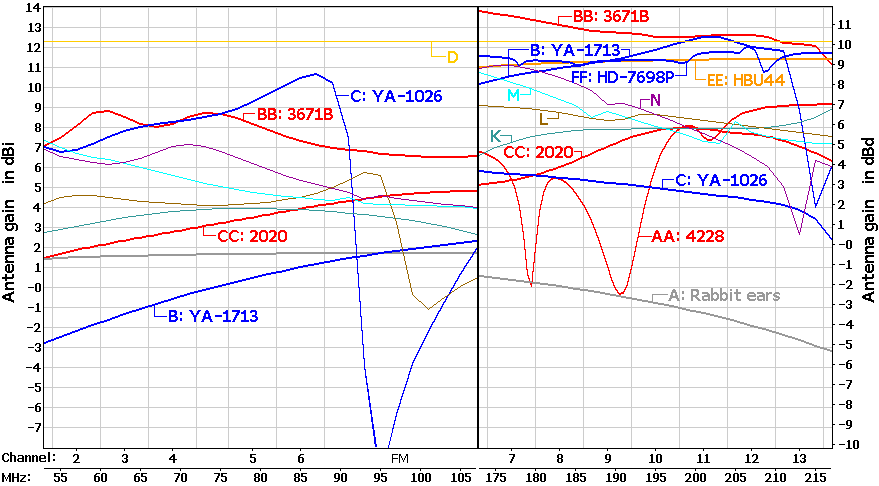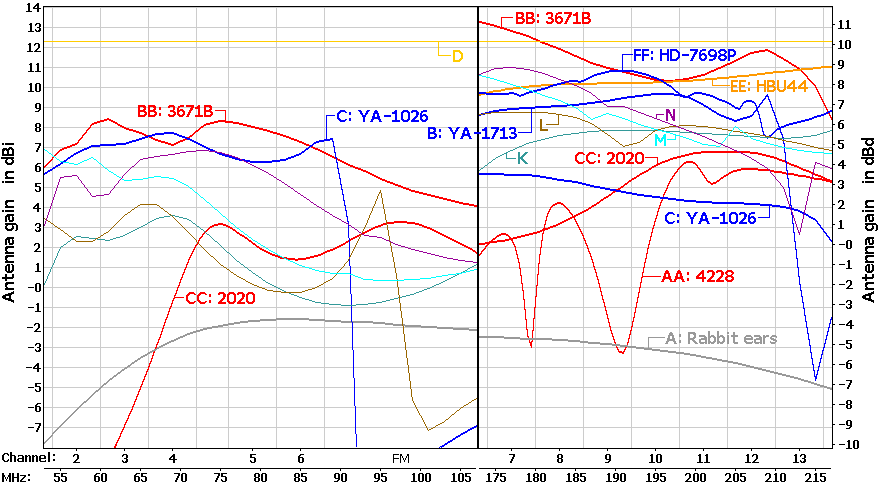10/23/09
Comparing some
commercially available antennas
Antenna
marketing is a racket in that the less honest you are, the more antennas you
sell. (Nobody goes to court over a TV
antenna.) Gain figures published by antenna
makers are mostly useless, except maybe for comparing antennas by the same
maker. The data for all of the charts in
this section came from computer simulations of the antennas. The author performed the simulations.
Why computer
simulations? (non-essential reading)
A few years
ago QST, which is the principal publication of the HAM radio community,
announced that they would no longer accept advertising for antennas if the ads
contained gain figures that were measured experimentally. Henceforth any such gain figures would have
to be the result of computer simulations.
There were two big problems with the experimental data:
1. The experimental antenna is affected by its
surroundings. Computers can do true
“free space” modeling.
2. The process of choosing the surroundings
encouraged overly favorable choices.
Most of us would call it cheating, but they justified it to themselves
by the belief that their competitors were doing it.
The program
used for these simulations was NEC-4/EZNEC4 by Lewallen (W7EL), which is one of
the programs approved by QST. Data
points were produced every 12 MHz (UHF) or 2 MHz (VHF). Some problems were encountered which
necessitated approximations, so the data is not highly accurate. But the author stands behind the principal
features of the graphs and resulting conclusions. The antenna model files are available for
viewing.
(The files
are at http://www.hdtvprimer.com/SIMS/
. Go first to the file README.TXT.)
Raw Gain for some
common UHF antennas
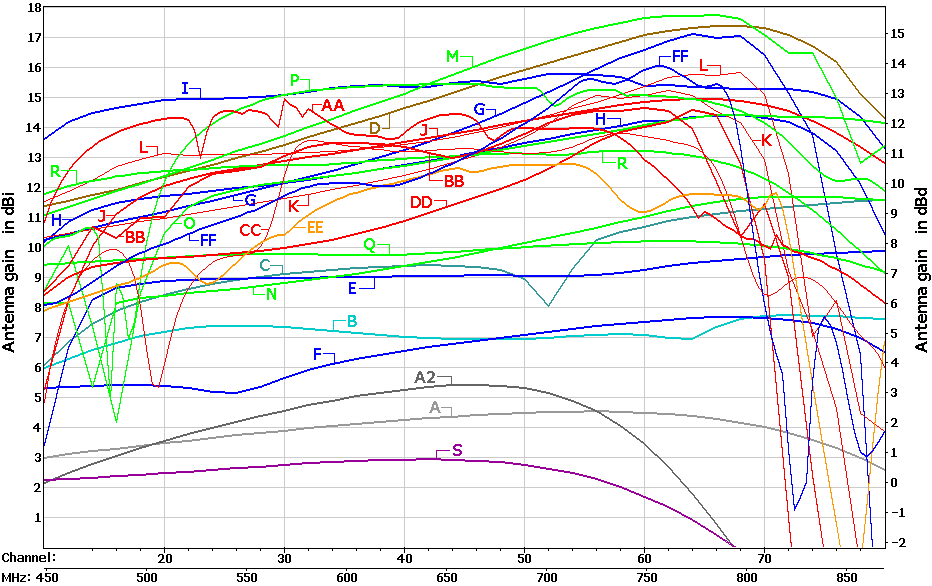
A Small indoor loops
B Zenith
Silver Sensor indoor LPDA
C Double-Bow
D Televes DAT-75 Yagi/Corner-Reflector
E Winegard
Square Shooter
F Winegard
SS-3000 Indoor Directional Antenna
G Winegard
PR-9032 Yagi/Corner-Reflector
H Winegard
PR-4400 4-Bay
I Winegard
PR-8800 8-Bay
J old Channel Master 4221 4-Bay
K Channel Master 4242 VHF/UHF Combo
L Channel
Master 4248 Yagi/Corner-Reflector
M AntennasDirect
XG91 Yagi/Corner-Reflector
N AntennasDirect
DB-2
O AntennasDirect
DB-4 4-Bay
P old
AntennasDirect DB-8 8-Bay
Q Antennas
Direct ClearStream 2
R Antennas
Direct ClearStream 4
S MegaWave Wideband Indoor Antenna
AA old Channel Master 4228 8-Bay
BB Channel Master 3671B VHF/UHF Combo
CC Channel
Master 2020 VHF/UHF Combo
DD Channel Master 3018 VHF/UHF Combo
EE AntennaCraft
HBU44 VHF/UHF Combo
FF Winegard
HD-7698P VHF/UHF Combo
Raw
gain is
the true gain, as gain is defined. But a
fraction of the power is going to be rejected by the transmission line because
of an impedance mismatch. This rejected
power gets retransmitted. What is left
is the net gain. The following
graphs are the ones you should pay the most attention to.
Net Gain for some
common UHF-only antennas
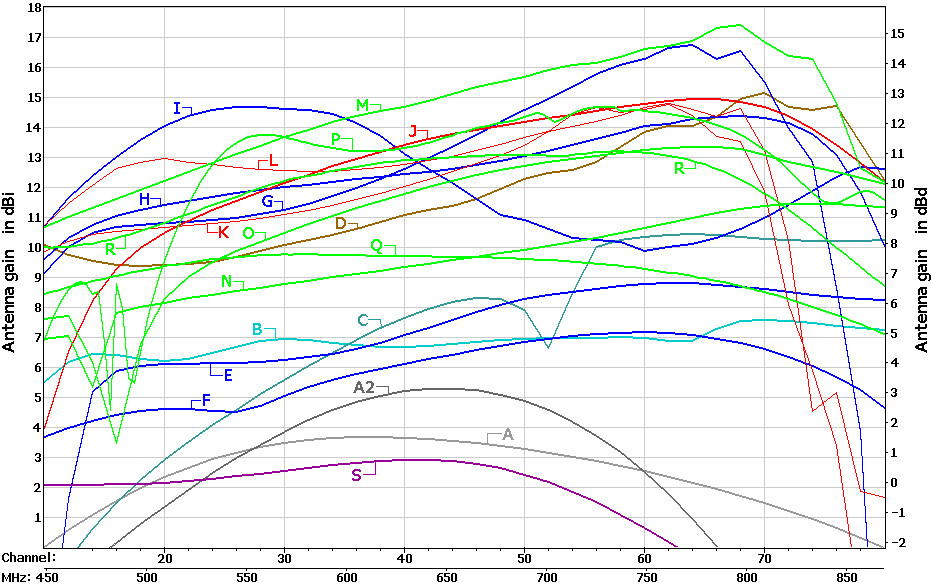
B Zenith Silver Sensor
indoor LPDA
D Televes DAT-75 Yagi/Corner-Reflector
F Winegard
SS-3000 Indoor Directional
Antenna
G Winegard PR-9032 Yagi/Corner-Reflector
J old Channel Master 4221 4-Bay
(3021)
K Channel Master 4242 VHF/UHF Combo
L Channel Master 4248 Yagi/Corner-Reflector (3023)
M AntennasDirect XG91 Yagi/Corner-Reflector
P new AntennasDirect
DB-8
8-bay old DB8
Q AntennasDirect ClearStream 2
R AntennasDirect ClearStream 4
S MegaWave Wideband Indoor Antenna
Net UHF Gain for
some common combo antennas
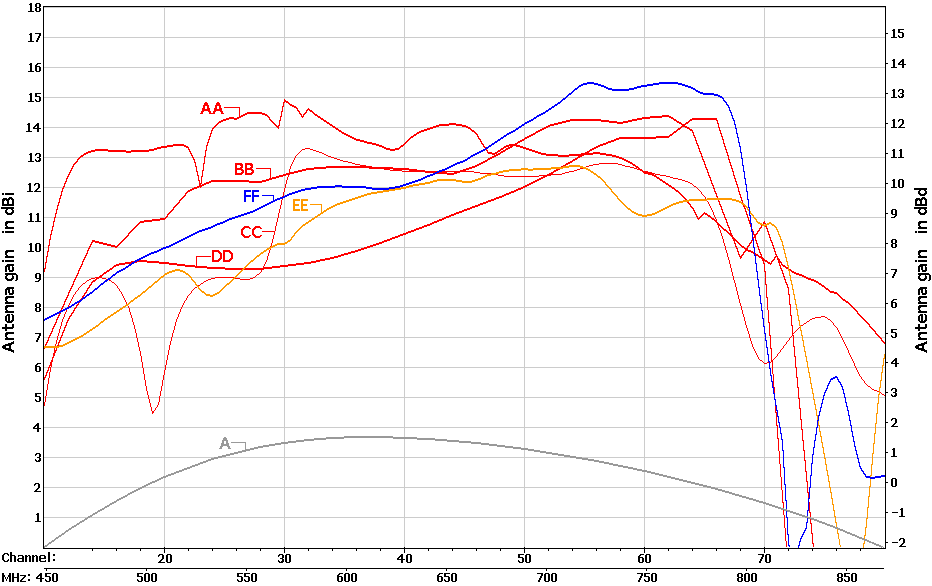
AA new Channel Master
4228HD 8-bay
BB Channel Master 3671B VHF/UHF Combo
CC Channel Master 2020
VHF/UHF Combo
DD Channel
Master 3018 VHF/UHF Combo
EE AntennaCraft HBU44
VHF/UHF Combo
FF Winegard HD-7698P VHF/UHF Combo
Click on the
antennas above to see more data about each antenna.
The 4242 and
3018 represent typical Yagi/Corner-Reflector UHF antennas that are part of a
VHF/UHF combo. You can estimate any
other unknown such antenna from these two.
Just find the length of the UHF part of the boom of the unknown antenna
(measured from the intersection of the corner planes to the front-most
director). Comparing this length to the
4242 and 3018 will let you estimate where the plot for the unknown lies in the
above graph.
The 4242 has
a 87“ boom (UHF part).
The 3018 has
a 57“ boom (UHF part).
Raw gain for some
common VHF antennas
A Rabbit ears –
40” 45°
B Winegard YA-1713 Wideband Yagi for VHF 7-13
C Winegard
YA-1026 Wideband Yagi for VHF 2-6
D Wade single channel Yagis
K Radio Shack VU-75XR
VHF/UHF combo
L Radio Shack VU-90XR
VHF/UHF combo
M Radio Shack VU-120XR
VHF/UHF combo
N Radio Shack VU-190XR
VHF/UHF combo
AA Channel
Master 4228
BB Channel Master 3671B VHF/UHF combo
CC Channel Master
2020
DD Channel
Master 3018
EE AntennaCraft
HBU44
FF Winegard
HD-7698P
Explanation (non-essential reading)
Why
show raw gain when net gain is what is important?
1. If atmospheric noise exceeds receiver noise then
the raw gain is what counts. (This is
rare for VHF or UHF but does occur in some neighborhoods.)
2. To determine which of two antennas has a
narrower beam on a given channel, just compare their gains at that
channel. But in this case you use the raw
gain, not the net gain. Raw gain is also
called directivity.
3. There are cable-matching methods that make
the net gain as good as the raw gain for any channel. But while these methods make some channels
better, they make other channels worse, and there is seldom an overall
improvement. There is presently no
hardware available that lets consumers improve the match, except for some
indoor antennas.
4. The program that predicts net gain is not
very accurate. Net gain is affected by
minor details in the way the cable attaches to the antenna. The raw gains are very accurate.
Note
that this website is probably alone in using the term “raw gain”. Other references simply call it the gain.
Net gain for some
common VHF antennas
B Winegard YA-1713
Wideband Yagi for VHF 7-13
C Winegard YA-1026
Wideband Yagi for VHF 2-6
D Wade single channel
Yagis (discontinued)
K Radio Shack VU-75XR VHF/UHF combo (discontinued)
L Radio Shack VU-90XR VHF/UHF combo (discontinued)
M Radio Shack VU-120XR VHF/UHF combo (discontinued)
N Radio Shack VU-190XR VHF/UHF combo (discontinued)
BB Channel Master 3671B VHF/UHF combo
If all the elements are parallel (as in a straight-type LPDA) then there will be nulls at +90° and –90° that might be useful for eliminating interfering signals.
Getting the
most out of rabbit ears
Using a UHF antenna
for VHF
Some UHF antennas are advertised as working for VHF also. As the following net gain graph shows, there
is not much truth in that. For channels
7-13, the MegaWave and the Winegard PR-8800 perform about as well as rabbit
ears. The Square Shooter is terrible for
all VHF channels. All of these antennas
are useless for channels 2-6.
The surprise here is the Channel Master 4228, which has a lot of
gain for VHF-high, especially channels 9-13.
What makes it different is the screen that is continuous across all 8
dipoles. Other 8-bays, like the 8800 and
the DB-8, have a reflector that is not continuous across the right and left
halves, and thus they have no useful gain for VHF. Channel Master is preparing a new version of
the 4228 that will likely be even better for VHF-high.
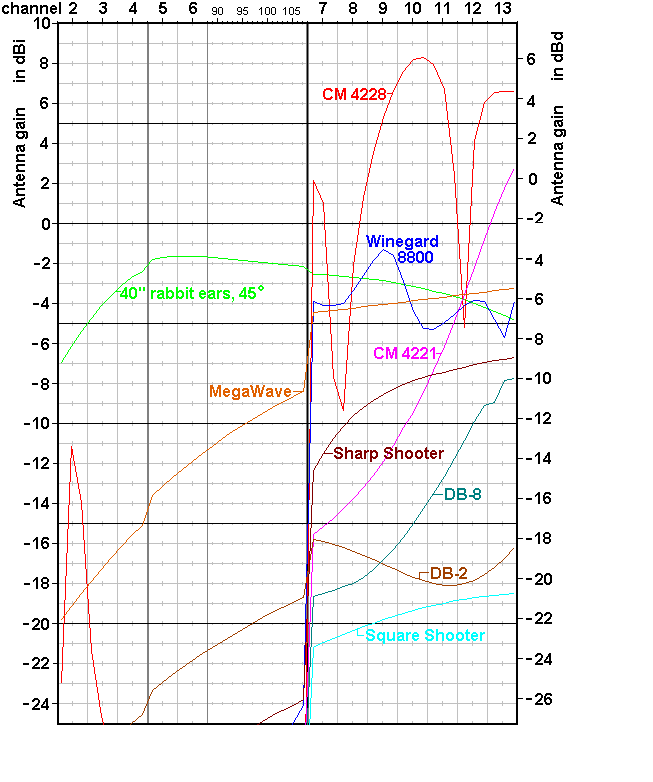
Related topics
Stores and
websites supplying antenna equipment
This page is part of “An HDTV Primer”, which
starts at www.hdtvprimer.com
